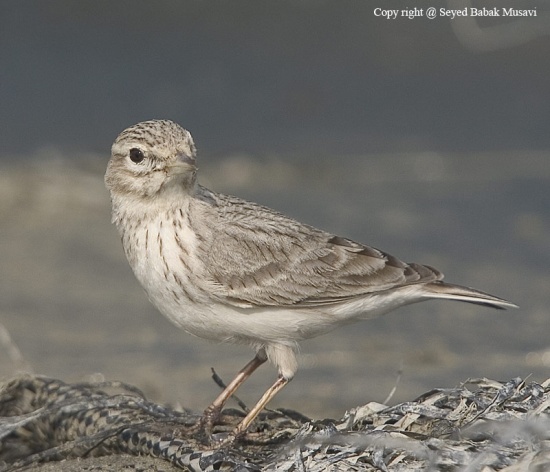Aloktewari (talk | contribs) (Song file added) |
|||
| (9 intermediate revisions by 5 users not shown) | |||
| Line 1: | Line 1: | ||
| − | + | '''Alternative name: Indian Short-toed Lark''' | |
| − | [[Image:Indian_Short-toed_Lark.jpg|thumb|550px|right|Photo by Seyed Babak Mus]] | + | [[Image:Indian_Short-toed_Lark.jpg|thumb|550px|right|Photo by {{user|Seyed+Babak+Mus|Seyed Babak Mus}}<br />Near the shore in Soorgalm Creek, [[Iran]]<!--EDITORS: This picture does not appear in the Gallery-->]] |
| + | ;[[:Category:Alaudala|Alaudala]] raytal | ||
| + | ''Calandrella raytal'' | ||
==Identification== | ==Identification== | ||
| − | + | 12–13 cm (4¾-5 in) | |
| − | + | *Greyish sandy overall plumage | |
| − | + | *Dark brown streaks | |
| + | *White underparts, sparsely and indistinctly dark-streaked on the flanks | ||
| + | *Greyish-white [[Topography#Heads|supercilium]] | ||
| + | *White cheeks | ||
| + | *Long slender bill | ||
| + | *Shortish tail | ||
==Distribution== | ==Distribution== | ||
| − | + | [[Image:DSC04933.JPG|thumb|450px|right|Photo by {{user|Shantilal+Varu|Shantilal Varu}}<br />Kutch, Gujarat, [[India]], June 2014]] | |
| − | + | [[Middle East]] and [[Asia]]:<br /> | |
| − | + | '''Middle East''': occurs only in [[Iran]]<br /> | |
| + | '''Asia''': [[Tibet]], [[Nepal]]<br /> | ||
| + | '''South Asia''': [[Pakistan]], [[India]], Eastern and Western [[Himalayas]]<br /> | ||
| + | '''Southeast Asia''': [[Indochina]] and [[Myanmar]] | ||
==Taxonomy== | ==Taxonomy== | ||
| + | ====Subspecies==== | ||
| + | [[Image:DSC04186.JPG|thumb|350px|right|Displaying<br />Photo by {{user|Shantilal+Varu|Shantilal Varu}}<br />Bhavnagar, Gujarat, [[India]], April 2014]] | ||
| + | There are 3 subecies<sup>[[#References|[1]]]</sup>: | ||
| + | *''A. r. raytal'': | ||
| + | :*Coastal south-eastern [[Iran]] to [[Afghanistan]], northern [[India]] and southern [[Myanmar]] | ||
| + | *''A. r. krishnakumarsinhji'': | ||
| + | :*North West India (Kathiawar Peninsula) | ||
| + | *''A. r. adamsi'': | ||
| + | :*Coastal north-western India | ||
==Habitat== | ==Habitat== | ||
| − | + | Salt pans, river banks, and river islets, sandy coastal areas. | |
==Behaviour== | ==Behaviour== | ||
| − | + | ====Diet==== | |
| − | + | There is little detail known about their diet, but it is known to consist of seeds, invertebrates and all snails. | |
| − | + | ====Breeding==== | |
| − | + | Nesting Season: February to May. The nest on the ground forming a cup-shaped depression for the eggs; usually at the base of a shrub. It is lined with grass and hair etc. The clutch consists of two or three eggs which have brown freckles on and yellowis or greyish-white background. They, and the young, are cared for by both adults. | |
| − | + | ====Vocalisation==== | |
| − | + | <flashmp3>Sand_Lark.mp3</flashmp3><br /> | |
| + | ''[[Media: Sand_Lark.mp3|Listen in an external program]]''<br /> | ||
| + | Recording by {{user|aloktewari|Alok Tewari}}<br /> | ||
| + | [[Pong Dam Lake Wildlife and Bird Sanctuary]], [[India]], Jan-2011<br /> | ||
| + | Call given by the bird circling overhead, recorded while sitting in a boat during bird-census. | ||
| + | ==References== | ||
| + | #{{Ref-Clements6thAug16}}#Avibase | ||
| + | #Handbook of the Birds of the World Alive (retrieved August 2016) | ||
| + | #Wikipedia | ||
| + | {{ref}} | ||
| + | ==External Links== | ||
| + | {{GSearch|Lark+raytal}} | ||
| + | <br /> | ||
| + | {{Video|Sand_Lark}} | ||
| − | + | [[Category:Birds]][[Category:Alaudala]] [[Category:Videos]] [[Category:Bird Songs]] | |
| − | |||
| − | |||
| − | [[Category: | ||
Revision as of 16:39, 28 August 2016
Alternative name: Indian Short-toed Lark
- Alaudala raytal
Calandrella raytal
Identification
12–13 cm (4¾-5 in)
- Greyish sandy overall plumage
- Dark brown streaks
- White underparts, sparsely and indistinctly dark-streaked on the flanks
- Greyish-white supercilium
- White cheeks
- Long slender bill
- Shortish tail
Distribution
Middle East and Asia:
Middle East: occurs only in Iran
Asia: Tibet, Nepal
South Asia: Pakistan, India, Eastern and Western Himalayas
Southeast Asia: Indochina and Myanmar
Taxonomy
Subspecies
There are 3 subecies[1]:
- A. r. raytal:
- Coastal south-eastern Iran to Afghanistan, northern India and southern Myanmar
- A. r. krishnakumarsinhji:
- North West India (Kathiawar Peninsula)
- A. r. adamsi:
- Coastal north-western India
Habitat
Salt pans, river banks, and river islets, sandy coastal areas.
Behaviour
Diet
There is little detail known about their diet, but it is known to consist of seeds, invertebrates and all snails.
Breeding
Nesting Season: February to May. The nest on the ground forming a cup-shaped depression for the eggs; usually at the base of a shrub. It is lined with grass and hair etc. The clutch consists of two or three eggs which have brown freckles on and yellowis or greyish-white background. They, and the young, are cared for by both adults.
Vocalisation
<flashmp3>Sand_Lark.mp3</flashmp3>
Listen in an external program
Recording by Alok Tewari
Pong Dam Lake Wildlife and Bird Sanctuary, India, Jan-2011
Call given by the bird circling overhead, recorded while sitting in a boat during bird-census.
References
- Clements, J. F., T. S. Schulenberg, M. J. Iliff, D. Roberson, T. A. Fredericks, B. L. Sullivan, and C. L. Wood. 2016. The eBird/Clements checklist of birds of the world: v2016, with updates to August 2016. Downloaded from http://www.birds.cornell.edu/clementschecklist/download/
- Avibase
- Handbook of the Birds of the World Alive (retrieved August 2016)
- Wikipedia
Recommended Citation
- BirdForum Opus contributors. (2024) Sand Lark. In: BirdForum, the forum for wild birds and birding. Retrieved 25 April 2024 from https://www.birdforum.net/opus/Sand_Lark
External Links






